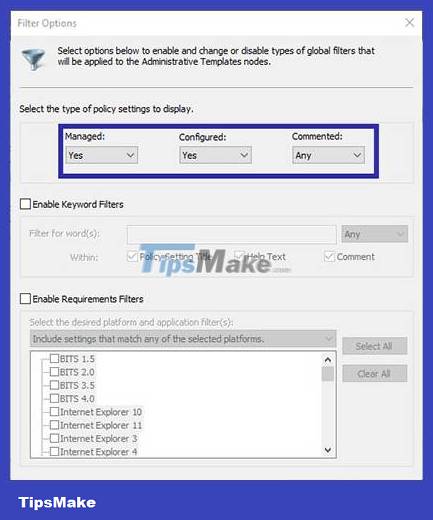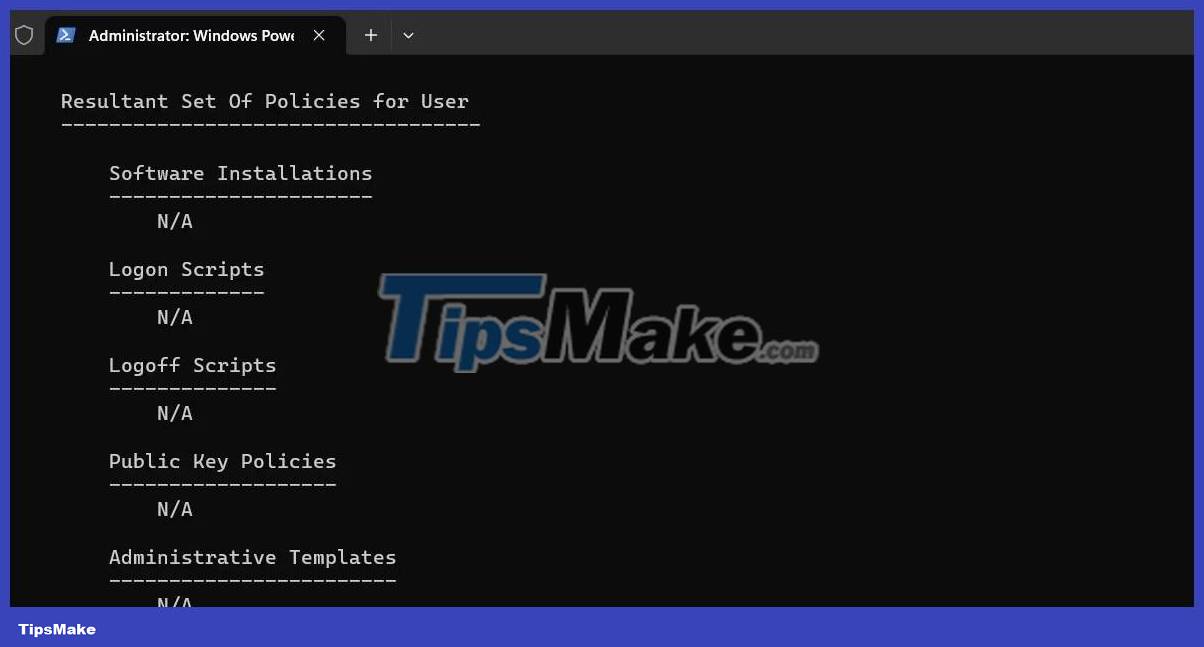How to view all applied Group Policies in Group Policy Editor
Windows' built-in Group Policy Editor allows you to quickly apply system-wide or user-specific policies and features with just a few clicks. In fact, many Windows instructions often ask you to edit Group Policy Objects.
If you're someone who changes a lot of policies to make Windows work the way you want, it's important to keep track of all those policy changes. This is especially true for new users. Mainly because, if something goes wrong with the policy change process, finding the policy quickly will help you restore the system. Not to mention, having a quick view of all policies applied or changed helps you understand system configuration better.
So, in this quick article, let's look at how to find all applied group policies in Windows.
Use the Resultant Set of Policy tool
Windows has a built-in tool called Resultant Set of Policy . This tool only displays policies that are enabled or disabled. Since all policies that are applied or changed will be in one of these two states, you can use this simple tool to find applied policy groups.
1. First, open the Start menu , search for "rsop.msc" and click on the result. Or, open the Run dialog box with the keyboard shortcut Win+ R, type "rsop.msc" and press Enter.
2. As soon as you do that, the Resultant Set of Policy tool will open. It will immediately scan the system. It may take a few seconds.

3. Once done, you can see all the applied policies by expanding the folders on the left panel.

Very simple, right? You've got all the information you need about applied policies in a single tool.
Use Filter Options in GPEdit to find the applied policy
Instead, you can also use the filtering function in Group Policy Editor. The only downside to this method is that you have to filter all three main folders separately: Software Settings, Windows Settings and Administrative Templates that appear in the Computer Configuration and User Configuration sections . Most useful and configurable policies are located in Administrative Templates.
1. First, open the Start menu , search for Edit Group Policy and click the result to open Group Policy Editor.
2. In Group Policy Editor , right-click on the folder that appears on the left panel and select the Filter Options option.

3. In the Filter Options window , set the options in Select the type of policy settings to display as follows and click the OK button to save the changes.
- Managed → Yes
- Configured → Yes
- Commented → Any

From now on, Group Policy Editor will only display enabled and disabled policies.
How to view group policy applied with PowerShell
Another method for determining which policy is applied to a Windows user or computer involves using PowerShell. If you are someone who likes to use command line tools to interact with or make changes to your computer, this method may be useful.
To view group policies applied using PowerShell, follow these steps:
- Press Win + S to open the search menu.
- Type powershell in the text box and select Run as administrator .
- Select Yes when the User Account Control (UAC) prompt appears.
- Enter the following command in the PowerShell window and press Enter :
gpresult /Scope User /v 
When you run the above command, you will see all the policies applied in the Resultant Set Of Policies for User section . If you want to see all policies applied to the computer, use the following command instead:
gpresult /Scope Computer /vFor more useful commands, be sure to check out TipsMake's guide to the best PowerShell commands for Windows.
Knowing how to check the policies applied to your Windows computer can be helpful when troubleshooting a problem with a program or feature or when you're concerned about your privacy or security. Luckily, this is easy with the methods mentioned above.
You should read it
- Use Group Policy Filtering to create a NAP DHCP enforcement policy - Part 1
- How to use Local Group Policy Editor to tweak your computer
- How to apply Group Policy only to non-administrators in Windows 10
- 8 'tweak' Windows Group Policy any Admin should know
- Configure App-V with Group Policy Objects
- Use Group Policy Filtering to create a DHCP enforcement policy for NAP - Part 2
- How to install the Microsoft Edge Group Policy template on Windows 10
- What is GPEdit.Msc (Group Policy Editor)? How to use GPEdit to configure a computer
May be interested
- What is GPEdit.Msc (Group Policy Editor)? How to use GPEdit to configure a computer
 if you are a person who does not like to sit still, like playing around with components on hardware, computer software, you've probably been playing in the group policy editor. this is one of the interesting windows extensions that support users to fine tune the operating system.
if you are a person who does not like to sit still, like playing around with components on hardware, computer software, you've probably been playing in the group policy editor. this is one of the interesting windows extensions that support users to fine tune the operating system. - Microsoft lists Windows 10 group policies that you should avoid touching
 microsoft has just released a list of 25 policies that administrators should not touch on windows 10 and windows 11. the reason is because they do not provide optimal results or cause unexpected things.
microsoft has just released a list of 25 policies that administrators should not touch on windows 10 and windows 11. the reason is because they do not provide optimal results or cause unexpected things. - Configure App-V with Group Policy Objects
 group policy objects are increasingly used in centralized management of settings, especially for software products installed on many systems.
group policy objects are increasingly used in centralized management of settings, especially for software products installed on many systems. - How to install the Microsoft Edge Group Policy template on Windows 10
 on windows 10, you can download and install group policy templates to manage microsoft edge settings, and this guide will show you the process.
on windows 10, you can download and install group policy templates to manage microsoft edge settings, and this guide will show you the process. - How to install Group Policy Editor (GPEdit.Msc) on Windows 10 Home Edition
 this article will guide you how to automatically activate gpedit.msc after running the batch file. this method works well on windows 10 home edition as well as on previous windows home versions such as windows 7 home edition and windows 8 / 8.1 home edition.
this article will guide you how to automatically activate gpedit.msc after running the batch file. this method works well on windows 10 home edition as well as on previous windows home versions such as windows 7 home edition and windows 8 / 8.1 home edition. - 8 'tweak' Windows Group Policy any Admin should know
 windows group policy is a powerful tool used to configure many aspects of windows. most tweaking of windows group policy only admin can do. if you are an administrator of many other computers in your company or you have many other accounts on your computer, then you should take advantage of windows group policy to control other users' computer usage.
windows group policy is a powerful tool used to configure many aspects of windows. most tweaking of windows group policy only admin can do. if you are an administrator of many other computers in your company or you have many other accounts on your computer, then you should take advantage of windows group policy to control other users' computer usage. - Use Group Policy Filtering to create a DHCP enforcement policy for NAP - Part 3
 in this part 3, i will show you more about policies and see what they do in a dhcp enforcement solution.
in this part 3, i will show you more about policies and see what they do in a dhcp enforcement solution. - Don't waste money on Windows 11 Pro unless you need this feature!
 having a tool that packs so many useful functions into a single convenient menu makes this the single reason why you should consider using windows 11 pro.
having a tool that packs so many useful functions into a single convenient menu makes this the single reason why you should consider using windows 11 pro. - Fixed an issue that could not replace Windows 10 desktop wallpaper with Group Policy
 if you try to change the desktop background with local group policy editor on windows 10 but fails, here is another solution.
if you try to change the desktop background with local group policy editor on windows 10 but fails, here is another solution. - Hide Control Panel on Windows 10 using Group Policy
 want to prevent others from changing settings on windows 10? this guide will help you disable control panel using group policy editor and registry editor, ensuring effective system security.
want to prevent others from changing settings on windows 10? this guide will help you disable control panel using group policy editor and registry editor, ensuring effective system security.










 How to Install Netflix
How to Install Netflix How to Create a Windows 7/Vista Bootable USB Drive
How to Create a Windows 7/Vista Bootable USB Drive How to Create New Files on Windows
How to Create New Files on Windows How to Find Windows 7 Product Key
How to Find Windows 7 Product Key How to Execute batch file from command line on Windows
How to Execute batch file from command line on Windows How to Add and Delete User Accounts with Command Prompt on Windows
How to Add and Delete User Accounts with Command Prompt on Windows